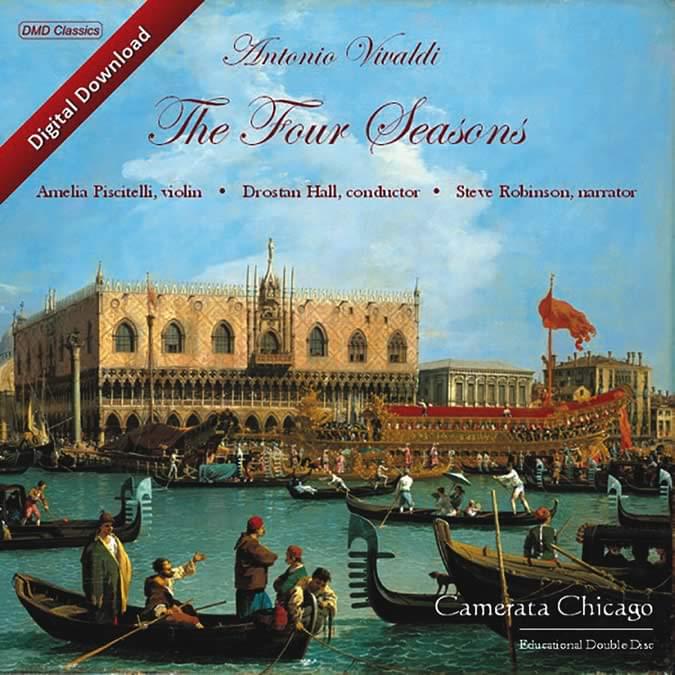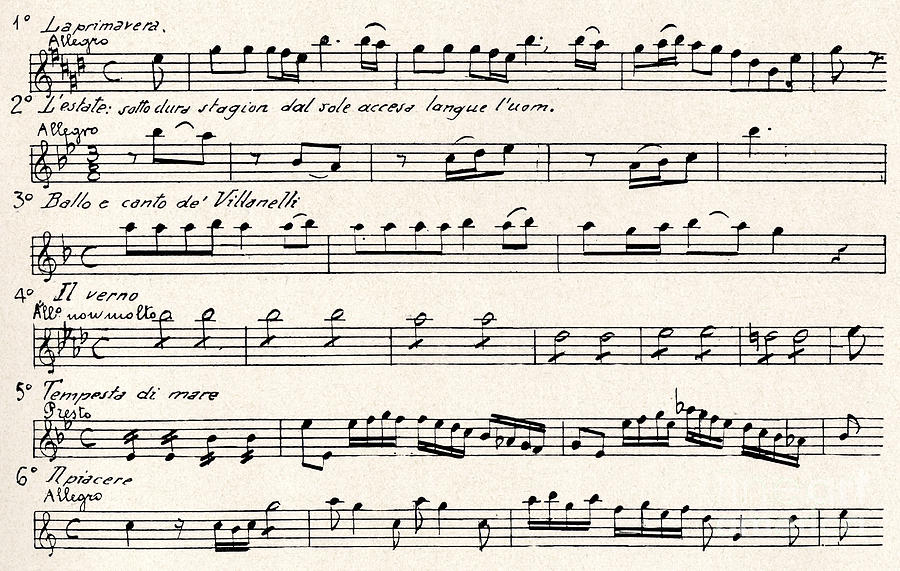Notes and Historical Information. Inspired by landscape paintings by Italian artist Marco Ricci. 1990 Pretty Woman (writer: 'Vivaldi: Autumn (The Four Seasons)', 'Vivaldi: Spring (The Four Seasons)', 'Vivaldi: Winter (The Four Seasons)'). The Four Seasons, Italian Le quattro stagioni, group of four violin concerti by Italian composer Antonio Vivaldi, each of which gives a musical expression to a season of the year. They were written about 1720 and were published in 1725 ( Amsterdam ), together with eight additional violin concerti, as Il cimento dell’armonia e dell’inventione (“The Contest Between Harmony and Invention”). Download sheet music for Antonio Vivaldi. Choose from Antonio Vivaldi sheet music for such popular songs as 1 Piano 100 Songs, The Four Seasons: Spring, and Spring from the Four Seasons - Allegro easy. Print instantly, or sync to our free PC, web and mobile apps.
Our editors will review what you’ve submitted and determine whether to revise the article.
Join Britannica's Publishing Partner Program and our community of experts to gain a global audience for your work!Antonio Vivaldi Four Seasons Full Download
Raymond L. KnappSee All Contributors
Antonio Vivaldi, in full Antonio Lucio Vivaldi, (born March 4, 1678, Venice, Republic of Venice [Italy]—died July 28, 1741, Vienna, Austria), Italian composer and violinist who left a decisive mark on the form of the concerto and the style of late Baroque instrumental music.

Life
Antonio Vivaldi - Four Seasons
Vivaldi’s main teacher was probably his father, Giovanni Battista, who in 1685 was admitted as a violinist to the orchestra of the San Marco Basilica in Venice. Antonio, the eldest child, trained for the priesthood and was ordained in 1703. His distinctive reddish hair would later earn him the soubriquetIl Prete Rosso (“The Red Priest”). He made his first known public appearance playing alongside his father in the basilica as a “supernumerary” violinist in 1696. He became an excellent violinist, and in 1703 he was appointed violin master at the Ospedale della Pietà, a home for foundlings. The Pietà specialized in the musical training of its female wards, and those with musical aptitude were assigned to its excellent choir and orchestra, whose much-praised performances assisted the institution’s quest for donations and legacies. Vivaldi had dealings with the Pietà for most of his career: as violin master (1703–09; 1711–15), director of instrumental music (1716–17; 1735–38), and paid external supplier of compositions (1723–29; 1739–40).
Soon after his ordination as a priest, Vivaldi gave up celebrating mass because of a chronic ailment that is believed to have been bronchial asthma. Despite this circumstance, he took his status as a secular priest seriously and even earned the reputation of a religious bigot.
Vivaldi’s earliest musical compositions date from his first years at the Pietà. Printed collections of his trio sonatas and violin sonatas respectively appeared in 1705 and 1709, and in 1711 his first and most influential set of concerti for violin and string orchestra (Opus 3, L’estro armonico) was published by the Amsterdam music-publishing firm of Estienne Roger. In the years up to 1719, Roger published three more collections of his concerti (opuses 4, 6, and 7) and one collection of sonatas (Opus 5).
Vivaldi made his debut as a composer of sacred vocal music in 1713, when the Pietà’s choirmaster left his post and the institution had to turn to Vivaldi and other composers for new compositions. He achieved great success with his sacred vocal music, for which he later received commissions from other institutions. Another new field of endeavour for him opened in 1713 when his first opera, Ottone in villa, was produced in Vicenza. Returning to Venice, Vivaldi immediately plunged into operatic activity in the twin roles of composer and impresario. From 1718 to 1720 he worked in Mantua as director of secular music for that city’s governor, Prince Philip of Hesse-Darmstadt. This was the only full-time post Vivaldi ever held; he seems to have preferred life as a freelance composer for the flexibility and entrepreneurial opportunities it offered. Vivaldi’s major compositions in Mantua were operas, though he also composed cantatas and instrumental works.
The 1720s were the zenith of Vivaldi’s career. Based once more in Venice, but frequently traveling elsewhere, he supplied instrumental music to patrons and customers throughout Europe. Between 1725 and 1729 he entrusted five new collections of concerti (opuses 8–12) to Roger’s publisher successor, Michel-Charles Le Cène. After 1729 Vivaldi stopped publishing his works, finding it more profitable to sell them in manuscript to individual purchasers. During this decade he also received numerous commissions for operas and resumed his activity as an impresario in Venice and other Italian cities.
In 1726 the contralto Anna Girò sang for the first time in a Vivaldi opera. Born in Mantua about 1711, she had gone to Venice to further her career as a singer. Her voice was not strong, but she was attractive and acted well. She became part of Vivaldi’s entourage and the indispensable prima donna of his subsequent operas, causing gossip to circulate that she was Vivaldi’s mistress. After Vivaldi’s death she continued to perform successfully in opera until quitting the stage in 1748 to marry a nobleman.
In the 1730s Vivaldi’s career gradually declined. The French traveler Charles de Brosses reported in 1739 with regret that his music was no longer fashionable. Vivaldi’s impresarial forays became increasingly marked by failure. In 1740 he traveled to Vienna, but he fell ill and did not live to attend the production there of his opera L’oracolo in Messenia in 1742. The simplicity of his funeral on July 28, 1741, suggests that he died in considerable poverty.

After Vivaldi’s death, his huge collection of musical manuscripts, consisting mainly of autograph scores of his own works, was bound into 27 large volumes. These were acquired first by the Venetian bibliophile Jacopo Soranzo and later by Count Giacomo Durazzo, Christoph Willibald Gluck’s patron. Rediscovered in the 1920s, these manuscripts today form part of the Foà and Giordano collections of the National Library in Turin.
- born
- March 4, 1678
Venice, Italy
- died
- July 28, 1741 (aged 63)
Vienna, Austria
- notable works
- movement / style
Antonio Vivaldi
The Four Seasons
Born in Venice, Italy, March 4, 1678; died in Vienna, Austria, July 28, 1741
So popular is Vivaldi's The Four Seasons today that it seems incomprehensible that these four delightful concertos should have languished in the musical attic for more than 200 years before re-appearing around 1950, just in time for the invention of the long-playing record. For it was the LP that spread the Seasons' fame throughout the world, making it probably the most recorded classical work of them all.

How Vivaldi would have loved all those royalties! After a long and illustrious career in which he composed some 800 works — including 500 concertos for virtually every instrument extant in his time, as well as operas and church music — he died a pauper in 1741 in Vienna, far from his native Venice. But in his prime, he was a celebrated violin virtuoso, and his dynamic concertos influenced many other contemporary composers, including J. S. Bach.
By the 1720s, Vivaldi was devoting some of his time to the service of Count Wenzeslaus von Morzin of Bohemia. In 1725, he dedicated a remarkable new publication of 12 concertos, entitled Ilcimento dell'armonia e dell'invenzione ('The Trial of Harmony and Invention'), to the Count — the first four of these concertos being TheFour Seasons. But scholars believe the Seasons were actually composed a few years earlier, probably around 1720, making them contemporaries of Bach's Brandenburg Concertos.
Although Vivaldi had written other concertos with colorful titles, the Seasons took descriptive writing several steps farther by graphically illustrating four sonnets, possibly written by Vivaldi himself, which are included in the original printed edition. Moreover, Vivaldi added verbal cues in the scores so performers would know exactly what they were representing: whether a barking dog in the second movement of “Spring” or a drunkard wobbling through the first movement of “Autumn.”
Here are a few highlights to listen for in each concerto.
“Spring” (E Major) is viewed, along with “Autumn,” as a benign season in which Mother Nature brings unclouded happiness to humankind. Its opening movement features enchanting birdsong for the soloist and two other solo violins. According to the accompanying sonnet, the slow movement describes a goatherd slumbering in the fields; listen for the “woof-woof” of his watchful dog in the violas. The final Allegro is a pastoral bagpipe dance in a rustic meter with the lower strings providing the drone.
In G minor, “Summer” is the most threatening of the seasons. Its imaginative opening movement is a portrait of summer's breathless heat, with rumbles of a thunderstorm in the distance. The soloist imitates the rapid song of the cuckoo and later the turtledove and goldfinch. We hear the background buzz of insects in the slow movement as the peasant sleeps restlessly, fearing the coming storm that might damage his crops. In the last movement, the storm finally breaks with all the fury Vivaldi could muster from his small ensemble.
The bountiful harvests of “Autumn” (in the traditional hunting-horn key of F Major) are celebrated by a sober peasant-dance ritornello in the first movement. But the soloist has drunk far too much, and his inebriated antics provide delightful virtuoso opportunities. Vivaldi wrote in the slow movement's score that this is the sleep of the drunken revelers; the harpsichord takes the foreground over muted strings. The most fascinating movement is the last: a detailed scenario of an autumn hunt with the horses' stately prancing, the baying dogs, rattling gunfire, and the soloist as the fleeing stag, who dies just before the final ritornello.
In F minor, “Winter” is another menacing season. Vivaldi may be recalling here the terrible winter of 1708–9 when Venice's lagoon froze over. In an extraordinary opening movement, the chattering instruments enter one by one, piling up harsh dissonances to evoke the bitter cold. By contrast, the slow movement in warm E-flat Major conjures up the cozy atmosphere indoors by the fire, with the pattering raindrops outside imitated by plucked violins. The final Allegro describes people walking slowly on the ice, then quickly with frequent falls. As the string winds blow, the music reminds us that winter also brings pleasure as well as discomfort. Parasparam serial latest episode youtube.
Notes by Janet E. Bedell copyright 2018
